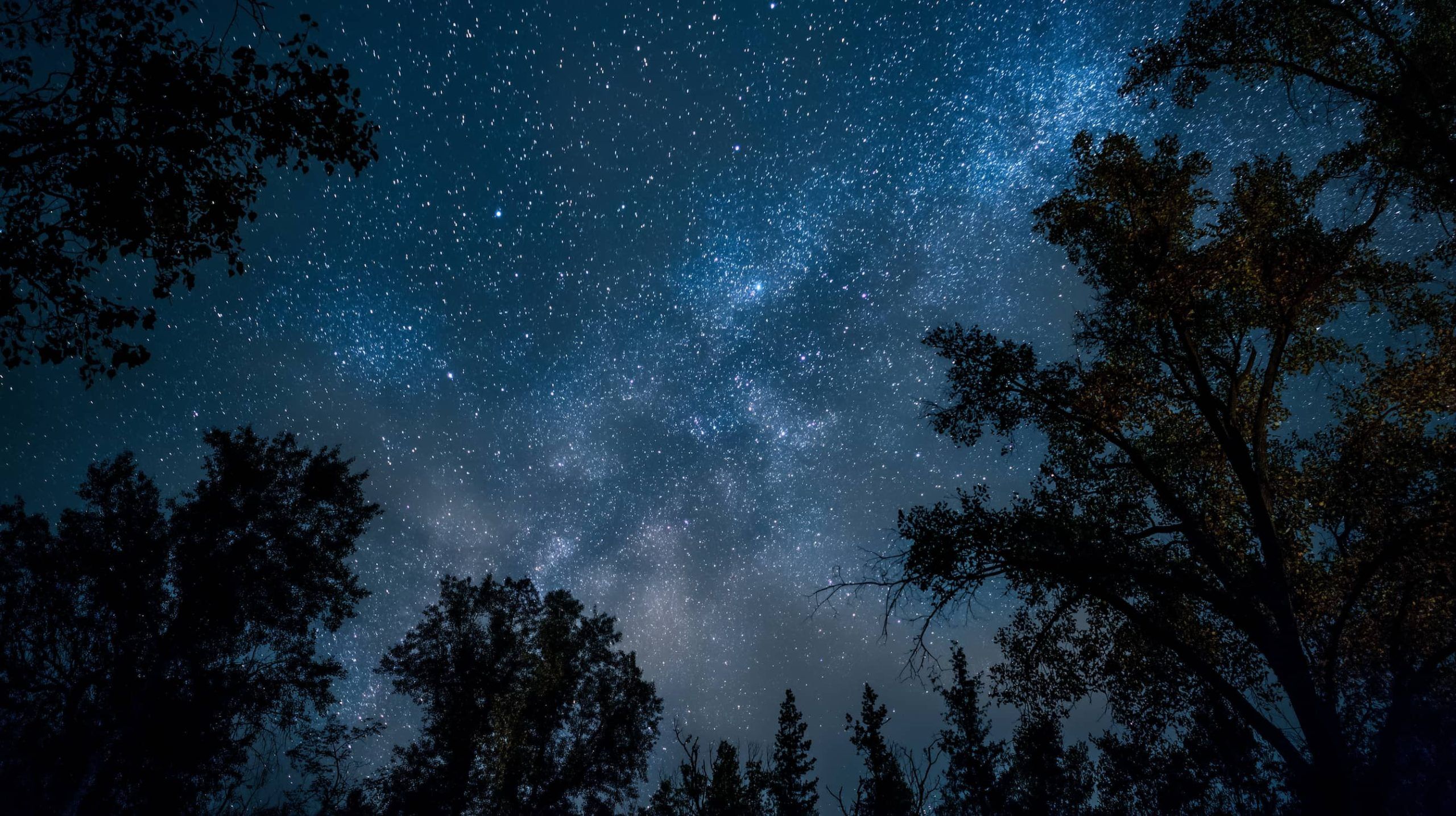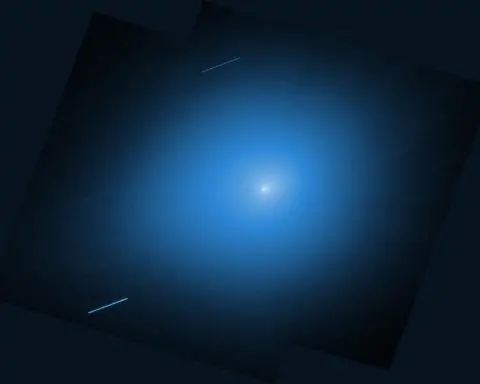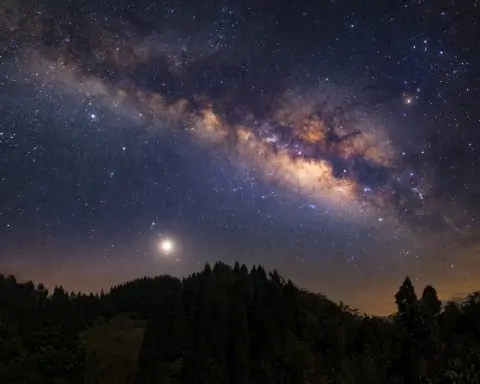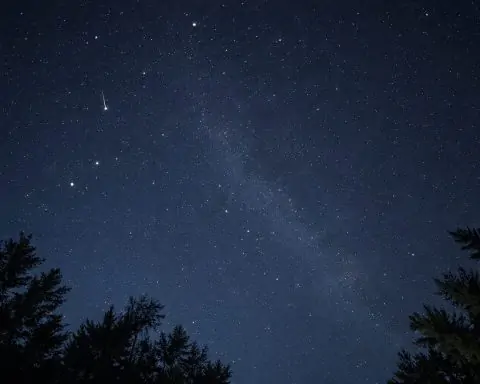- A rare Black Moon occurred on August 23, 2025, as Summer 2025 had four new moons (June 25, July 23, Aug 23, Sept 21), yielding ultra-dark skies for Aug 24–26.
- Perseid meteors, peaking Aug 12–13 at up to ~100 per hour under ideal dark skies, were heavily washed out by an 84%-full Moon, leaving observed rates around 15 per hour in many areas.
- Kappa Cygnids, a minor shower peaking around Aug 16 at ~3 meteors per hour, can still produce slow, bright fireballs, though by late August rates are under 1 per hour.
- Venus (-4 mag) and Jupiter (about -2 mag) form a bright dawn pair in the eastern sky, separated by a few degrees after their Aug 11–12 close approach, visible about 60–30 minutes before sunrise.
- Mercury, the innermost planet, reached its greatest western elongation on Aug 19 and remains visible very low in the east about 30–45 minutes before sunrise.
- Saturn shines at about magnitude +0.6, rises around 9–10 pm, and, near its 2025 opposition, offers prominent rings and moons through a telescope; Titan’s shadow transited Saturn on Aug 18.
- Mars is very faint and low in the west after sunset, but on Aug 26 the slender Moon will meet Mars just after sunset for a brief, binocular-friendly sighting.
- All five naked-eye planets can be seen during Aug 25–26, with a notable four-planet glimpse about an hour before dawn on Aug 25–26 as Saturn sits in the west while Venus, Jupiter, and Mercury glow in the east.
- The International Space Station makes predawn passes around 4–5 am for many locations, and China’s Tiangong space station can also be visible on some nights, while SpaceX Starlink trains from Aug 17 and Aug 22 launches have spread out by Aug 23–25.
- A NASA Wallops sounding rocket (TOMEX+ mission) was planned for Aug 25 between 10 p.m. and 3 a.m. EDT, potentially visible as a brief light streak near Wallops Flight Facility.
The nights of August 25–26, 2025 are packed with celestial sights – from the last flickers of a famous meteor shower to a pre-dawn planet parade, plus dark moonless skies, a chance (albeit small) for auroras, bright space station flyovers, and even a rocket launch visible to some lucky observers. With a rare “Black Moon” having just occurred, no moonlight will interfere with stargazing, making these nights ideal for skywatchers. Below we break down each phenomenon – what it is, when/where to see it, and why it’s special – in an accessible way for all. Mark your calendars, set your alarms, and look up – the universe is putting on a show! [1]
Meteor Showers: Perseids’ Final Flickers (and a Surprise Fireball or Two?)
Perseid Meteors – a last gasp: The famed Perseid meteor shower, which peaked in mid-August, is now winding down [2]. During the August 12–13 peak, the Perseids can produce up to ~100 “shooting stars” per hour under ideal dark skies – but this year a glaring 84%-full Moon washed out most of the fainter meteors [3]. (Meteor experts noted that the bright moonlight held peak observed rates to only ~15 per hour in many areas [4].) The good news is that the Moon is gone now, so any remaining meteors this week won’t be drowned out [5]. The Perseids officially remain active until about August 23–24 [6] [7], meaning you could still catch a few stray Perseid meteors on the nights of Aug 25–26. Don’t expect a torrent – realistically it may be on the order of only a few meteors per hour at best [8] [9]. Still, even one bright fireball can steal the show on a dark night. The Perseids are known for occasional spectacular, long-lasting meteors, and a week or two after the peak, “stragglers” can include some of the shower’s brightest fireballs that were late to the party [10]. In short, keep an eye out – any fast streak in the sky these nights might be a last Perseid making its fiery plunge into Earth’s atmosphere.
Why it happens: The Perseids occur each year as Earth passes through debris left by Comet Swift-Tuttle. Tiny bits of comet dust (mostly sand-grain to pea-sized) slam into our atmosphere at ~59 km/s and burn up, producing the light streaks we call meteors [11] [12]. All Perseid meteors appear to radiate from the constellation Perseus in the northeast sky (hence the name) [13]. For best viewing, find a dark spot away from city lights, lie back and watch the late-night to pre-dawn hours – that’s when your location on Earth faces into the meteor stream, potentially yielding more meteors [14] [15]. Give your eyes ~20 minutes to adapt to the darkness, be patient, and enjoy the breathtaking Milky Way while you wait [16] [17]. Even if Perseid counts are low, you’ll likely catch a few random background (“sporadic”) meteors as well – nature’s wildcard bonus [18].
Bonus fireballs – the Kappa Cygnids: Late August isn’t only about the Perseids. Another minor meteor shower, the κ (kappa) Cygnids, has been active this month (roughly July 23 – August 27, peaking around Aug 16) [19]. The Kappa Cygnids are much weaker – only around ~3 meteors/hour even at peak [20] – but they have a special reputation: they often produce slow, bright “fireball” meteors. In fact, NASA notes the Kappa Cygnids have “delivered memorable fireballs in past years” despite their low numbers [21]. By late August this shower is fizzling out (rates now are less than 1 per hour [22]), so you’d be lucky to spot one. How to tell if you do? Perseid meteors are fast and streak from the northeast, whereas a Kappa Cygnid fireball would move a bit more slowly and, if traced backward, would lead to the northern sky near Cygnus (high overhead in the evening) [23]. Essentially, it’s an encore meteor possibility – most of the time you won’t see many, but there’s always a chance of an eye-popping meteor from one of these minor showers. As one astronomy publication quipped, with minor showers “most of the time you won’t see many, but there’s a chance of an eye-popping meteor” [24]. Keep your eyes peeled just in case – a single brilliant meteor on a dark night is worth the watch!
Global visibility: Note that meteor showers favor certain hemispheres. The Perseid radiant rises high in the Northern Hemisphere sky, so observers in North America, Europe, and Asia get the best show. In the Southern Hemisphere, the Perseid radiant stays low near the horizon or never rises at all, so few Perseids are seen (perhaps the occasional “earthgrazer” meteor skimming the horizon) [25]. Kappa Cygnids likewise are a northern specialty (radiant in northern sky) [26]. So northern skywatchers with dark skies have the advantage for catching any meteors this week. Southern stargazers might not see these particular showers, but can still enjoy the glorious Milky Way core overhead on these moonless nights – and of course any random meteors that do appear. Either way, moonless darkness will make any meteor you do catch more vivid. Bundle up, get comfy, and keep looking up!
New Moon = Ultra-Dark Skies (Hello, “Black Moon”!)
While meteors provide the fireworks, the Moon – or rather, its absence – is the unsung hero of these nights. On August 23, the Moon reached its New Moon phase (exact at 06:06 UTC on Aug 23) [27]. This wasn’t just any new moon; it was an especially rare “Black Moon.” In astronomical terms, a Black Moon refers to an extra new moon in a season that normally has only three [28]. Summer 2025 has four new moons (June 25, July 23, Aug 23, Sept 21), so the Aug 23 new moon was the third of those four – hence a seasonal Black Moon [29]. (Another definition of Black Moon is the second new moon in a calendar month, but that doesn’t apply this time [30].) Black Moons only happen about once every 33 months, but what matters for skywatchers is: no moonlight all night long. With the Moon essentially invisible (its sunlit side is facing away from us), the nights of Aug 24–25–26 are completely moonless, offering exceptionally dark skies [31].
Why dark skies matter: On a moonless night, faint celestial objects pop into view that would otherwise be washed out. The Milky Way’s dense star clouds in Sagittarius and Cygnus shine brilliantly overhead in late August [32] [33]. Star clusters and nebulae can be spotted with binoculars or telescopes. And of course, faint meteors that a bright moon would hide are now visible. In short, these are prime conditions for stargazing. If you can escape city lights during these dark nights, you’ll be rewarded with a dazzling sky full of stars – the summer Milky Way stretching across the sky is a breathtaking sight [34] [35].
Catching the young crescent: The Black Moon itself is invisible on Aug 23 (unless it causes a solar eclipse, which this one did not). But you can try to spot the Moon’s return as a razor-thin crescent on the following evenings. On Sunday Aug 24, about 30–40 minutes after sunset, look very low near the western horizon for a fragile silver sliver – that’s the 1-day-old crescent Moon, only ~1% illuminated [36]. It will be a delicate, thin arc against the twilight (binoculars may help). If you miss it, Monday Aug 25 the crescent will be a bit higher and ~5% sunlit – still a slim Moon, but slightly easier to see [37]. By Tuesday Aug 26, the growing crescent will have moved a little higher and will pair up close to Mars in the dusk sky (more on that below) [38]. You might also notice “earthshine” on the dark side of the Moon – that soft ghostly glow is sunlight reflected from Earth faintly lighting the lunar night side. Spotting an ultra-young Moon is a fun challenge even for seasoned observers, so give it a try!
No eclipse this time: This new moon isn’t causing any eclipses on these dates – its alignment wasn’t precise enough with the Sun. (New moons cause solar eclipses only if they line up just right with Earth and Sun.) The next significant lunar event is a big one: a total lunar eclipse on Sept 7–8, 2025, which will turn the full Moon blood-red for over an hour [39]. That “Blood Moon” will be visible across much of the world (Asia, Australia, Europe, Africa) [40]. So enjoy these pristine dark nights now, and get excited for that dramatic eclipse in two weeks!
Bottom line: The Black Moon means ideal viewing conditions right now. With the sky at its darkest, faint stars and meteors stand out in stark relief [41]. Take advantage of these moonless nights to simply gaze at the stars. For example, the Andromeda Galaxy (M31) is high in the east by late night; the Summer Triangle (bright stars Vega, Deneb, Altair) overhead frames numerous star clusters and nebulae. If you have a telescope or binoculars, now’s a great time to sweep around Sagittarius and Cygnus – you’ll be amazed what a dark sky reveals [42] [43]. And for naked-eye observers, just soaking in the Milky Way arching across the sky is an unforgettable experience.
Planets on Parade: Dawn Alignments and an Evening Cameo
Not to be outdone by the meteors, the planets are putting on a show as well. In fact, all five naked-eye planets (Mercury, Venus, Mars, Jupiter, Saturn) can be observed at some point during these nights if you plan carefully. Three of them even form a beautiful pre-dawn alignment, while another shines all night. Here’s where and when to find the planets on Aug 25–26:
- Venus & Jupiter – Brilliant duo at dawn: If you’re up before sunrise, you can’t miss the two brightest planets Venus and Jupiter shining together in the eastern sky. Venus has recently returned to the morning sky (after its inferior conjunction) and now blazes as the “Morning Star” at a stunning magnitude –4, very bright [44]. Jupiter, higher up in the east, is dimmer (about mag –2) but still outshines any true star at that hour [45]. Earlier this month, Venus and Jupiter had an extremely close conjunction – on Aug 11–12 they appeared only ~1° apart, a spectacular sight [46]. By Aug 25, they have separated a bit more but are still only a few degrees apart, making for an eye-catching pair of “stars” at dawn [47]. Venus will be the lower, more brilliant one; Jupiter will be slightly above and to Venus’s right (from mid-northern latitudes). Unlike twinkling stars, planets shine with a steady light, so look for two steady beacons low in the east about 60–30 minutes before sunrise. As dawn brightens, Venus will be the last object visible before it fades into daylight [48]. NASA calls the August Venus-Jupiter meetup “the real highlight of August” for skywatchers [49], so if you haven’t seen this planetary pairing yet, now is a great time (they won’t appear this close again for some time). Bonus: Through a telescope, you might glimpse Jupiter’s moons or catch that Venus shows a tiny crescent phase!
- Mercury – a tricky little addition:Mercury, the innermost planet, is also visible in the morning now – but it’s a challenge. It reached its greatest western elongation (furthest separation from the Sun in the dawn sky) on Aug 19 [50]. Around Aug 25–26, Mercury is still very low in the east about 30–45 minutes before sunrise [51]. You’ll need a flat, unobstructed horizon (and perhaps binoculars) to spot it. Look for a modest star-like point just above the east-northeast horizon, below Venus and Jupiter. It will only be visible in the very early twilight – by 20 minutes before sunrise it’s likely lost in the Sun’s glow [52]. Many people have never seen Mercury with the naked eye (it’s often hidden by sun glare), so this is a good opportunity if you have clear conditions. Tip: Start scanning ~45 minutes before your local sunrise, and never look through binoculars once the Sun is about to rise (for safety). Mercury will be far below the Venus/Jupiter duo – basically, if you draw a line through Jupiter and Venus and continue it downward toward the horizon, that’s where Mercury emerges [53]. Catching Mercury will be easiest on these dates just after elongation, before it sinks back toward the Sun. Good luck – spotting the elusive Mercury is like earning a special skywatcher merit badge!
- Saturn – ringed jewel ruling the night: Over in the opposite part of the sky, Saturn takes center stage in the late-night hours. Saturn is approaching its 2025 opposition (in late September), which means it’s already near its biggest and brightest for the year [54]. Right now Saturn shines around magnitude +0.6 [55] – bright enough to rival a prominent star – in the constellation Aquarius. It rises in the east by mid-evening (~9–10 pm local time in late August) and stays visible all night [56], moving high across the southern sky and then into the west by dawn [57]. Essentially, Saturn is doing the full circuit: it “comes up at sunset and sets at sunrise” when at opposition, and we’re nearly at that point. Look for a steady, pale yellowish point of light in the southeast after dark – that’s Saturn [58]. Again, planets don’t twinkle much, so Saturn’s steady glow will stand out amid the stars of Aquarius and Capricornus. It’s not as eye-searingly bright as Jupiter or Venus, but it’s one of the brighter points in that area of sky. If you have a telescope, now is prime time to enjoy Saturn’s gorgeous rings and moons – even a small scope will show the rings. In fact, around opposition, Saturn’s rings brighten extra due to an effect called the Seeliger effect, so you might notice Saturn appears a touch more radiant than usual [59]. (Also, earlier this week on Aug 18, lucky observers with large telescopes caught Titan’s shadow transiting Saturn – a rare event [60], showing that Saturn is indeed well-placed for observation now.) Don’t miss Saturn ruling the late-summer night – it’s a beautiful sight to the naked eye, and through a scope it’s unforgettable.
- Mars – a fading sunset cameo:Mars is the one major planet that’s a bit out of the spotlight. It has been lingering low in the west at dusk, but it’s now quite faint and getting harder to see each day. Mars is currently far from Earth (we won’t have a close bright Mars until 2027), so it’s only about as bright as one of the dimmer stars of the Big Dipper [61]. It also sets shortly after the Sun, lost in twilight. By Aug 25–26, Mars will be very tough to spot for most casual observers. However, there’s a special opportunity on Aug 26: the slender crescent Moon will meet up with Mars that evening. Look just after sunset on Aug 26, very low in the western sky, and you might catch the thin crescent Moon with a faint orange dot (Mars) right beside it [62]. They’ll only be above the horizon for roughly an hour after sunset [63], so there’s not much time to observe. Binoculars could help you pick Mars out of the twilight glow. If you find them, it’s a lovely tableau – the Moon’s crescent and Mars’s tiny spark of light about 5° apart. But don’t worry if you miss Mars now; it will return to prominence in the future. By late this year and especially in 2027, Mars will come to a bright opposition again. For now, consider Mars a bonus challenge object. If you have very clear skies and perhaps optical aid, you might glimpse the Red Planet’s ember-like glow very low after sunset, near where the Sun went down [64].
All told, with a bit of planning you can see all five classical planets in one night this week. Here’s a possible itinerary: shortly after sunset, try to spot Mars briefly in the west; then enjoy Saturn rising and staying up through the night; and by the pre-dawn hours, look east to catch Mercury, Venus, and Jupiter clustered together [65]. In fact, in the hour before dawn on Aug 25 or 26, you could momentarily see four planets at once – Saturn setting in the west while Venus, Jupiter, and Mercury adorn the eastern sky [66]. That’s essentially a planet parade spread across the entire sky! (And for the record, Uranus and Neptune are up there too – Neptune lies not far from Saturn in Aquarius, and Uranus is in Aries before dawn – but you’d need a telescope or strong binoculars to find those distant ice giants [67].) It’s relatively rare to have so many planets visible at once, so take a moment to appreciate the solar system on display. As NASA’s skywatching team might say, it’s one of those times when “the planets align” for a fantastic viewing opportunity.
Expert insight: Remember, planets don’t twinkle like stars do. If you’re scanning the sky and see a bright point that shines with a steady light, not a flicker, it’s likely a planet. Use this trick to help distinguish planets from similarly bright stars on these nights.
Auroras & Space Weather: What’s the Outlook?
After the meteors and planets, you might wonder: Will the Northern (or Southern) Lights make an appearance? The short answer for Aug 25–26 is: probably not much, barring an unexpected outburst from the Sun. But it’s worth understanding the context – especially since earlier this week, aurora watchers did get a surprise treat.
Recent aurora surprise: Just a few days ago, on the night of Aug 19–20, skywatchers were buzzing about an unexpected aurora display that dipped much farther south than usual for summertime. A minor geomagnetic storm (G1-class) struck Earth’s magnetic field, and the Aurora Borealis was visible in at least 10 U.S. states during the night of Aug 19–20 [68]. Observers reported seeing the Northern Lights as far south as northern Illinois and Iowa (around 42°N latitude), and across states like Montana, North Dakota, Wisconsin, Michigan, New York, New Hampshire and more [69]. People described faint green and purple glows or pulsating curtains on the northern horizon in those mid-latitudes [70]. Seeing auroras that far south in August is rare – usually, a much stronger (G3 or G4) geomagnetic storm is needed to reach those latitudes. So this was essentially a “rare summer light show” delivered by a relatively minor solar storm [71]. Similar auroras were reported in high latitudes globally too (southern Canada, Scotland and Scandinavia in Europe, and likely New Zealand’s South Island for the Aurora Australis) [72].
What caused it? Space weather forecasters noted a one-two punch from the Sun: a large coronal hole in the Sun’s atmosphere was spewing a fast solar wind stream toward Earth, and a small coronal mass ejection (CME) from an earlier solar flare delivered a “glancing blow” at about the same time [73]. The combination of the high-speed solar wind plus the minor CME was enough to disturb Earth’s magnetic field and trigger a G1 aurora storm in surprising places [74]. It’s a reminder that the Sun is getting more active as we approach the peak of its 11-year cycle (expected around 2025/2026), and even minor space-weather events can spark auroras when conditions line up [75]. In fact, NOAA and other agencies note that as solar maximum nears, auroras will likely increase in frequency and reach lower latitudes more often [76]. We’re already seeing that trend.
Current forecast (Aug 25–26): For the nights of August 25–26, no major geomagnetic storm is predicted at the moment. The energy from that Aug 19 solar wind stream has dissipated, and NOAA’s 3-day forecast shows only quiet to unsettled conditions, with the planetary Kp index possibly peaking around 3 (below storm level) [77]. In other words, there is no new aurora watch or alert in effect for these dates, and significant auroral activity is not expected unless the Sun throws us an unpredicted surprise. As of Aug 24, the Sun had been relatively calm in terms of Earth-directed flares or CMEs [78]. (Interestingly, a rapid CME did erupt on the far side of the Sun on Aug 21, but since it was not aimed at Earth, it has no impact on us [79].) Barring any sudden solar flare or eruption in the next day, Earth’s magnetic field should stay mostly quiet over Aug 25–26.
Aurora possibilities: If you’re at high latitudes – say, in northern parts of Canada, Alaska, northern Europe (Scandinavia, Scotland, etc.), or far-southern regions like Tasmania or New Zealand – it’s still worth keeping an eye on the sky in case of any minor auroral glows. Even with Kp 3 “active” conditions (below official storm level), a faint aurora low on the horizon isn’t out of the question for those locations [80]. But a big, dazzling display is unlikely this time. For most middle-latitude readers (e.g. most of the U.S. and Europe), you probably won’t see the Northern Lights this week. It never hurts to peek north around local midnight if you’re under a dark, clear sky in a northerly location – sometimes a very subtle greenish haze might be there and only show up clearly in a long-exposure photo. But manage your expectations: the quiet Sun means meteors and stars will likely be the stars of the show rather than auroras this week [81].
Looking ahead: We’re approaching the start of the traditional “aurora season” in the Northern Hemisphere. As nights lengthen in late August and September (after the midnight sun of summer fades), any geomagnetic disturbances that do occur will unfold under darker skies, making auroras easier to see. Statistically, the weeks around the September equinox often bring upticks in auroral activity (a phenomenon known as the Russell-McPherron effect, where Earth’s orientation in the solar wind around equinoxes can enhance geomagnetic responses) [82]. So even though nothing major is forecast for Aug 25–26, avid aurora chasers should stay alert in coming weeks – things can change quickly on the Sun. We’re only about two months from October, when another solar eclipse (Oct 2025) and likely more solar activity could spark auroras. As always with the aurora, expect the unexpected – a surprise solar flare can happen at any time and give only a day or two of warning. If you do get an alert, head away from city lights (even minor auroras can be drowned out by light pollution or haze) and find a spot with a clear view of the northern (or southern) horizon [83]. Often auroras appear as a faint grayish or pale green “cloud” to the eye; a camera with a long exposure will reveal the vivid greens and purples if they are present [84]. Peak aurora time is usually around local midnight to 2am, but it can vary. Patience is key – you might see nothing for hours, then suddenly a brief eerie glow dances for a minute and vanishes. That’s the thrill of aurora chasing! For this particular period, though, it looks like Mother Nature’s best light shows will be the meteors and Milky Way, not the aurora.
ISS Flyovers & Satellite Sights: Manmade “Stars” in the Sky
Not everything bright in the night sky is a natural star or meteor – humanity has placed some pretty bright objects up there too. The International Space Station (ISS) is the most famous (and brightest) artificial satellite, but it’s not alone. Here’s what to watch for in terms of satellites on Aug 25–26:
International Space Station (ISS): The ISS is a bus-sized orbiting laboratory ~400 km above Earth, inhabited by astronauts, and it regularly makes visible passes across the sky. When the Station’s solar panels catch the Sun’s light, it can outshine even Venus, appearing as a bright, steady white dot gliding across the sky [85]. It basically looks like an unblinking moving star (and moves much faster than an airplane). Unlike planes, the ISS has no flashing lights and no contrail – it doesn’t blink or leave a trail; it just shines with a constant brightness as it moves [86]. Each pass lasts only a few minutes as the ISS zips along at 28,000 km/h (~17,400 mph).
When and where to see it: The ISS’s visibility depends on your location and the timing – you can only see it when it’s dark in your area but the Station is still lit by the Sun (usually shortly after sunset or before sunrise). Around Aug 23–25, the ISS orbit is producing predawn passes for many mid-latitude locations (including much of the U.S., Canada, and Europe) [87]. In mid-August, lots of skywatchers in cities like New York, London, Warsaw, etc., saw bright ISS flyovers around 4:00–4:30 AM local time, and that pattern has been continuing [88]. So in the hour or two before sunrise, check if the ISS might be passing over your area. Some places may also start getting evening passes just after dusk as we head toward September [89] (it alternates every few weeks). The key is: if an ISS pass is going to occur, it usually appears in the western sky, travels across (high overhead or toward the south), then disappears in the east as it enters Earth’s shadow. It often just suddenly materializes (coming out of Earth’s shadow) – one moment nothing, then a bright dot appears – and a few minutes later it fades out abruptly when it slips back into darkness [90].
To find out exact times for your location, you can use NASA’s “Spot the Station” service or websites/apps like Heavens-Above [91]. Enter your city and they’ll list upcoming ISS sighting opportunities with directions (e.g. “Appears at 5:14 AM WNW, max altitude 45°, disappears SE at 5:19 AM”). If an ISS pass is listed as bright (magnitude –1 or brighter), it will be very noticeable [92]. Spotting the ISS is great fun – it’s moving at 7.6 km/s, so it crosses the sky in a couple minutes. If you catch it, give a wave – there are currently astronauts up there (Expedition 70 crew), and who knows, they might be gazing down at us as that bright point sails overhead [93]!
China’s Tiangong Space Station: China’s Tiangong space station is also orbiting Earth. It’s smaller than the ISS, but under dark skies it can still appear as a steady moving point of light (no blinking) when it passes over [94]. Tiangong isn’t as bright as the ISS at its best – it can get to about magnitude 0 or –1 at peak, which is as bright as a big star (for comparison, ISS can get to –4 at times, as bright as Venus) [95]. Still, if you know when to look, you can spot Tiangong on some nights. Its passes often occur at different times than ISS because it’s on a different orbit inclination. Check Heavens-Above or other trackers for the “CSS” (Chinese Space Station) to see if Tiangong is visible in your location. Seeing both the ISS and Tiangong in one night is an exciting double-feature for satellite watchers – a reminder that we now have multiple space stations shining back down at us.
“Trains” of Starlink satellites: In addition to space stations, there are thousands of other satellites up there. SpaceX’s Starlink constellation alone has launched over 4,000 internet satellites. Shortly after launch, these satellites travel together in a tight “train” of lights that can be startling to see – basically a straight line of dim stars moving in unison across the sky. Recently, a SpaceX Falcon 9 launch on Aug 17, 2025 deployed a new batch of Starlink satellites [96]. In the days immediately after (Aug 18–20), observers in some areas reported seeing a string of faint lights crossing the evening sky – those were the freshly launched Starlinks still in close formation [97]. By Aug 23–25, that particular batch has spread out and raised orbit, so a distinct “train” is less likely now [98]. However, SpaceX had another Starlink launch on Aug 22, and more are planned, so it’s possible you could catch an impromptu satellite train on these nights if one happens to pass over your region. These are usually visible shortly after sunset or before sunrise (when the satellites are catching sunlight while the ground is dark). They won’t be as bright as the ISS – often you need dark skies and advance notice to spot them – but if you do see a dozen tiny lights all moving in a row, you’ve probably spotted a Starlink convoy. It’s a pretty cool sight, though astronomers are concerned about the proliferation of such satellites cluttering the sky.
(Pro tip: the Heavens-Above site can provide predictions for Starlink passes as well, if you’re keen to track them.)
Satellite flares and space junk: Apart from organized “trains,” you might notice other random satellites gliding by if you stargaze for a while. Many will be faint, but occasionally one will “flare” – suddenly brighten for a few seconds – as its solar panel or antenna reflects sunlight directly toward you. The now-retired Iridium satellites (old comm satellites) were famous for their intense flares, but those have mostly been deorbited or replaced [99]. Still, you might catch a brief glint from an old rocket body or another satellite tumbling in orbit [100]. If you see a quick flash in the sky, or a satellite that grows brighter then dimmer periodically as it moves, it could be a piece of space junk rotating and catching the Sun. Keep in mind: satellites move in a straight line at steady speed and do not have red/green blinking lights – if you see flashing lights or hear jet noise, that’s an airplane! But a silent, steady moving “star” is likely a satellite.
Finally, note that rocket launches or reentries can occasionally create visible phenomena too (like strange glowing vapor trails or fireball-like streaks in the sky). On these particular dates, no major rocket launches are expected during the nighttime hours that would produce a visible sky show overhead [101]. (For example, a U.S. military Falcon 9 rocket launch late on Aug 21 from Florida did create glowing clouds near the launch site, but that was immediately at launch [102]. And an old rocket stage reentered earlier in the week, creating a brief “shooting star” sight for some observers [103], but nothing like that is predicted for this weekend.) Still, space can surprise us – so if you do see an odd moving light or streak that doesn’t fit the usual satellite or meteor profile, you might have witnessed a piece of human technology saying hello (or goodbye) in the sky.
Rocket Launch Alerts: Eyes on a NASA Launch (and SpaceX Test)
Even as we watch the skies, humanity keeps reaching for them. Here are any rocket launches happening on Aug 25–26 that might be visible to the public:
- NASA Sounding Rocket (TOMEX+ mission) – Planned launch: Monday, Aug. 25 (window 10 p.m.–3 a.m. EDT). NASA is launching a suborbital sounding rocket from Wallops Flight Facility in Virginia as part of an upper-atmosphere experiment (TOMEX+ mission) [104]. If you live in the U.S. Mid-Atlantic region, you may have a chance to spot this launch as a brief light streak in the sky. NASA provides a visibility map and notes: “Those in the mid-Atlantic region may catch a glimpse of the rocket, weather permitting.” [105] Basically, folks in eastern Virginia/Maryland, Delaware, maybe southern New Jersey or northeastern North Carolina should watch the western to southwestern sky (toward Wallops Island) during the launch window. The rocket will appear like a fast-moving point of light rising and then arcing out of view within a minute or two. The launch was delayed from the previous night due to weather, so fingers crossed for Aug 25. NASA Wallops will stream it online and post updates on social media [106]. If you’re in the potential viewing zone, this is a neat chance to see a real rocket launch with your own eyes – albeit a small suborbital one.
- SpaceX Starship test flight – Status: Scrubbed on Aug 24; new attempt TBD. Many eyes were on SpaceX’s Starbase in South Texas this weekend for a much-anticipated test flight of Starship, the world’s largest rocket. Liftoff of the fully stacked Starship with Super Heavy Booster was scheduled for Sunday Aug 24 at 7:30 p.m. EDT (2330 UTC) [107]. However, SpaceX scrubbed the launch attempt due to a ground systems issue just before launch time [108]. As of Aug 25, a new launch date hadn’t been announced publicly. It’s possible they will try again in the coming days after resolving the issue. If and when it launches, the Starship test flight will be primarily visible to those near the South Texas coast. During its April test, Starship produced a tremendous plume and could be seen from many miles away. A twilight launch could create high-altitude exhaust plumes visible in the dusk sky, but since the timing is uncertain, this is more a space news item than a skywatch event. We include it here because it’s a notable spaceflight event around these dates that many are following. Unless you’re in that region, you won’t see anything of Starship in the sky – but it’s exciting to know it’s happening. (And if you are in South Texas, stay tuned to SpaceX announcements for possible road closures and launch attempts – and be prepared for a spectacle if it flies!)
- Other launches: A few other rocket launches are on the schedule in this timeframe, but none are expected to create visible phenomena for widespread publics. For example, SpaceX and NASA launched a Cargo Dragon resupply mission to the ISS from Florida early on Aug 24 (pre-dawn hours), but that was only visible as a rocket flame to those near the Cape. On Aug 26, SpaceX plans a Falcon 9 launch from Vandenberg Space Force Base in California around 2:53 p.m. EDT (11:53 a.m. local PT) carrying a satellite [109]. Since that is a daytime launch, it won’t produce any of the dramatic glowing exhaust trails you sometimes see during night launches – at most, locals might see a contrail in the sky. Similarly, a small Canadian suborbital rocket test (by startup NordSpace) is scheduled for Aug 25 in Newfoundland [110], but it’s a low-altitude test unlikely to be noticed beyond the immediate area. And on Aug 23, Blue Origin launched a suborbital New Shepard flight in West Texas (a morning launch with a private crew) – exciting for participants but not something people could see unless they were at the launch site [111].
In short, the only potentially visible launch for general skywatchers on Aug 25–26 is the NASA Wallops sounding rocket for those in the U.S. East Coast vicinity [112]. No major orbital launch is expected to produce a “sky show” (like those dramatic twilight launch plumes) on these nights. Of course, plans can always change – rocket schedules often shift. So it’s always a good idea to stay tuned to space news sources if you’re interested in catching a launch in person.
In Summary: Enjoy the Show!
To recap, late August 2025 is treating us to a variety of celestial events, big and small. Here are the key skywatch highlights for August 25–26, 2025 and why they’re special:
- Dark Moon, Bright Stars: A rare “Black Moon” new moon has left skies ultra-dark all night [113] – perfect for stargazing. With no moonlight, you can see faint meteors, the Milky Way, and more detail in the night sky than usual.
- Perseid Meteors – Final Act: The Perseid meteor shower is winding down after its mid-August peak. Only a few meteors per hour may remain [114], but thanks to the dark sky, any stray fireballs will stand out. Don’t expect a storm, but keep watch after midnight for the occasional shooting star (the Perseids are famous for bright ones!).
- Surprise Fireballs?: The minor Kappa Cygnid meteors are nearly over, but have been known to throw the odd slow, bright fireball even late in August [115]. It’s a long shot, but any unusually slow, long-lasting meteor could be one – a little cosmic wildcard to be aware of.
- Planetary Showcase:Planets abound –
- Venus and Jupiter form a brilliant dawn pair low in the east before sunrise [116]. They were closest around Aug 11–12, but still shine only a few degrees apart, creating a gorgeous sight at 4–5am local time. Venus (blazing –4 mag) is the lower one; Jupiter (–2 mag) just above it [117].
- Mercury lurks below them, very low on the horizon ~30–45 minutes before sunrise [118]. It’s faint and tricky to spot, but this week is the best chance (it just had its max elongation). Look for a tiny dot beneath Venus/Jupiter in early dawn.
- Saturn rises in mid-evening and stays up all night [119]. Nearing opposition, it’s about as bright as it gets (mag ~+0.6) and visible in the southeast after dark, moving across the southern sky. Through a telescope, its rings are a must-see.
- Mars is very faint, low in the west at dusk – tough to see now. But on Aug 26, a young crescent Moon meets Mars after sunset [120]. Look west about 30–60 min post-sunset on 8/26 to catch the thin Moon with a tiny orange point nearby. They set within an hour, so act fast!
- Aurora Outlook: After a surprise minor aurora storm last week (which brought Northern Lights unusually far south [121]), Earth’s magnetic field is quieting down. No major auroras are forecast for Aug 25–26 [122] – any displays will likely be limited to high latitudes (Alaska, Canada, northern Europe) and faint at best. Of course, the aurora can be unpredictable, so high-latitude readers may still check the night sky just in case. But generally, don’t expect the Northern Lights unless the Sun throws an unexpected flare our way [123].
- Space Stations & Satellites: The ISS is making predawn passes for many locations (e.g. ~4–5am in parts of N. America & Europe) [124]. It looks like a bright, steady moving star gliding across the sky in a few minutes [125]. Use NASA’s Spot the Station to time your sightings. China’s Tiangong station can also be spotted (though dimmer) if passes occur overhead [126]. Keep an eye out for the odd satellite “train” of newly launched Starlinks after sunset – a line of tiny lights moving in unison [127] – as SpaceX just launched new batches on Aug 17 and 22. And you might see an occasional satellite flare or glint from tumbling space junk (a quick flash in the sky), even though the famous Iridium flares are mostly gone [128].
- Rocket Launches: The only notable launch during these nights is a NASA sounding rocket on Aug 25 (~10pm–3am EDT window) from Virginia. If you’re in the U.S. mid-Atlantic, you may catch a brief streak of light from this launch low on the horizon (weather permitting) [129]. No other night launches are expected to create visible effects. (SpaceX’s big Starship test was slated for Aug 24 but got scrubbed [130]; any new attempt will be announced later – primarily of interest to those near Starbase, Texas.)
In summary, August 25–26, 2025 offers a smorgasbord of skywatching delights: a dark moonless canvas filled with stars, the Milky Way, and lingering meteors; a dazzling planetary lineup at dawn and a Saturn showcase all night; a quiet but intriguing aurora scene at high latitudes; and human-made “stars” like the ISS making flybys. It’s a wonderful time to step outside after dark, let your eyes adjust, and simply enjoy the cosmos. Whether you’re chasing that one last Perseid meteor, admiring Venus and Jupiter in the twilight, or waving to astronauts passing overhead, there’s something for everyone. So spread a blanket, look up, and enjoy the celestial show – the universe is putting on a performance, and you’ve got front-row seats!
Sources:
- NASA – “What’s Up: August 2025” skywatching tips [131] [132]
- American Meteor Society – Meteor activity outlook for late August 2025 [133] [134]
- Royal Observatory Greenwich – Perseid schedule (Jul 17–Aug 24) [135]
- NASA Astronomy Picture of the Day – Kappa Cygnid meteor info [136]
- Travel + Leisure – August 2025 Night Sky Guide (planetary events) [137] [138]
- EarthSky.org – Solar activity and aurora forecast (Aug 24 update) [139] [140]
- NOAA Space Weather Prediction Center – Geomagnetic outlook (Kp index) [141]
- SpaceWeather.com – Aurora reports (Aug 19–20 storm) [142]
- NASA Wallops Flight Facility – Launch alert for Aug 25 sounding rocket [143]
- Spaceflight Now – SpaceX Starship test update (Aug 24) [144]
- Space.com – Launch schedule (Aug 26 Falcon 9 launch info) [145]
- TS2 Science & Tech Reports – “Black Moon Sparks Cosmic Show: Meteors, Planet Parade & Auroras on Aug 24–25, 2025” [146] [147] [148] [149] (event breakdown and expert tips)
References
1. ts2.tech, 2. ts2.tech, 3. science.nasa.gov, 4. ts2.tech, 5. ts2.tech, 6. ts2.tech, 7. science.nasa.gov, 8. ts2.tech, 9. www.amsmeteors.org, 10. ts2.tech, 11. science.nasa.gov, 12. science.nasa.gov, 13. ts2.tech, 14. ts2.tech, 15. ts2.tech, 16. ts2.tech, 17. ts2.tech, 18. ts2.tech, 19. ts2.tech, 20. ts2.tech, 21. ts2.tech, 22. www.amsmeteors.org, 23. ts2.tech, 24. ts2.tech, 25. ts2.tech, 26. ts2.tech, 27. ts2.tech, 28. ts2.tech, 29. ts2.tech, 30. ts2.tech, 31. ts2.tech, 32. ts2.tech, 33. ts2.tech, 34. ts2.tech, 35. ts2.tech, 36. ts2.tech, 37. ts2.tech, 38. ts2.tech, 39. ts2.tech, 40. ts2.tech, 41. ts2.tech, 42. ts2.tech, 43. ts2.tech, 44. ts2.tech, 45. ts2.tech, 46. ts2.tech, 47. ts2.tech, 48. ts2.tech, 49. science.nasa.gov, 50. ts2.tech, 51. ts2.tech, 52. ts2.tech, 53. ts2.tech, 54. ts2.tech, 55. ts2.tech, 56. ts2.tech, 57. ts2.tech, 58. ts2.tech, 59. ts2.tech, 60. ts2.tech, 61. ts2.tech, 62. www.travelandleisure.com, 63. www.travelandleisure.com, 64. ts2.tech, 65. ts2.tech, 66. ts2.tech, 67. ts2.tech, 68. ts2.tech, 69. ts2.tech, 70. ts2.tech, 71. ts2.tech, 72. ts2.tech, 73. ts2.tech, 74. ts2.tech, 75. ts2.tech, 76. ts2.tech, 77. ts2.tech, 78. ts2.tech, 79. ts2.tech, 80. ts2.tech, 81. ts2.tech, 82. ts2.tech, 83. ts2.tech, 84. ts2.tech, 85. ts2.tech, 86. ts2.tech, 87. ts2.tech, 88. ts2.tech, 89. ts2.tech, 90. ts2.tech, 91. ts2.tech, 92. ts2.tech, 93. ts2.tech, 94. ts2.tech, 95. ts2.tech, 96. ts2.tech, 97. ts2.tech, 98. ts2.tech, 99. ts2.tech, 100. ts2.tech, 101. ts2.tech, 102. ts2.tech, 103. ts2.tech, 104. www.nasa.gov, 105. www.nasa.gov, 106. www.nasa.gov, 107. spaceflightnow.com, 108. spaceflightnow.com, 109. www.space.com, 110. www.space.com, 111. www.space.com, 112. www.nasa.gov, 113. ts2.tech, 114. ts2.tech, 115. ts2.tech, 116. ts2.tech, 117. ts2.tech, 118. ts2.tech, 119. ts2.tech, 120. www.travelandleisure.com, 121. ts2.tech, 122. ts2.tech, 123. ts2.tech, 124. ts2.tech, 125. ts2.tech, 126. ts2.tech, 127. ts2.tech, 128. ts2.tech, 129. www.nasa.gov, 130. spaceflightnow.com, 131. science.nasa.gov, 132. science.nasa.gov, 133. www.amsmeteors.org, 134. www.amsmeteors.org, 135. ts2.tech, 136. apod.nasa.gov, 137. www.travelandleisure.com, 138. www.travelandleisure.com, 139. earthsky.org, 140. ts2.tech, 141. ts2.tech, 142. ts2.tech, 143. www.nasa.gov, 144. spaceflightnow.com, 145. www.space.com, 146. ts2.tech, 147. ts2.tech, 148. ts2.tech, 149. ts2.tech










